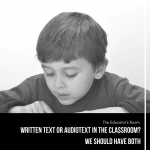Peer feedback is an essential tool to build stronger writers. But how exactly does one encourage fruitful peer feedback? I struggled with finding the best method that would stimulate meaningful comments among my students. At first, I would have students exchange papers and use generic checklists with items like “Is the thesis statement clear?” or “Are the body paragraphs logically organized?” (Some classes might get this question: “Is there a thesis statement at all?”) Usually, students would check off “yes” or “very strong” and write empty comments, such as, “I really like your paper! Good job!” or “I <3 you!” (I am not sure what that last comment had to do with the paper’s content). To correct this, I tried showing them how I would revise a paper by projecting a sample piece with a document camera and giving them a play-by-play of the process. Other times, I used the sample paper and let students take the lead. Students engaged in meaningful dialogue about what was not working for the paper how to correct the problems. I had made some progress; unfortunately, though, students were still failing to properly revise their peers’ papers individually. I knew something had to change, and I could not spare the class time to project every single student’s paper one at a time. (Not to mention I could not put that pressure on my more self-conscious pupils.)
I recently found a solution to my problem. It happened when I was planning a lesson for my AP Language & Composition students when I remembered an activity I had tried with my sophomores earlier this semester. Our sophomores were reading To Kill a Mockingbird by Harper Lee, and I tried the threaded discussion activity to generate dialogue about one of Scout’s many experiences. I first read about threaded discussion in a copy of Holt Elements of Literature, Fourth Course: Resources for Advanced Students. The book recommends threaded discussion to be used with a profound quote that every student replies to either by pen and paper or on a forum. Then, students read others’ responses and add onto their discussions. I liked this strategy so much that I knew I had to share it with the juniors in AP, but I also needed to incorporate more peer feedback. Therefore, I adapted it.
Rather than encourage discussion about a memorable quote or pressing issue, I required students to constructively criticize others’ writing. Here are the steps I took to modify the threaded discussion for peer feedback:
- Students read an article and responded to one of the issues it presented. They then created an argumentative or persuasive piece.
- Once they completed their response (which was only one paragraph for our purposes), they then passed their papers to a partner.
- I informed students that while it was OK to give “I agree” or “I disagree” comments, their ultimate goal was to challenge the original writer. (By this point, they already knew how to analyze a paper for rhetorical devices and errors in reasoning.)To keep feelings intact, I also told them to make at least one positive comment about the piece, aside from “I totally agree with you!”
- Next, students switched papers again and repeated the process. Except this time, they were told to respond to the person before them. Not only did they have to challenge the original writer, but they also had to challenge the person who gave the first round of feedback.
- At this point, I had students to return the papers to their rightful owners. Sample comments students wrote included:
- “I agree with what you’re saying, but the ‘other side’ can easily weaken your argument.” (The student then went on to describe the counter-attack.)
- “You make an excellent point here! You could also add this detail to make your argument stronger.”
- “I see where you’re coming from, but you should also consider the following point…”
- “You used great word choice here.”
- “This sentence is a bit awkward. Reword it.”
Success! I was amazed at the improvements from past experiences with peer feedback. Students were introducing counter-arguments that the original writer could prepare for, as opposed to just saying, “I agree with you!” or “I <3 you!” They also edited here and there, which is fine, but the main focus was where it needed to be – on the quality of the content.
Students followed up with this activity by rewriting their paragraphs with their peers’ comments in mind. Most students wrote better the second time around.
I think this process worked for two reasons. First, I did not reveal the entire procedure to them beforehand; I did not want them dreading peer feedback, and I wanted them focusing on one step at a time. Additionally, I likened this procedure to posting on a forum, except we were “low-teching” it for that day. Students immediately caught on and visibly brightened when they heard my analogy.
Just as I did, you can find several ways to adapt this method to your classroom. I have prepared some suggestions for you.
Go online! Recreate this process on an actual forum. Just make the guidelines and your expectations clear beforehand. Let students know how you will grade them. You may want to assign a lesser grade to the initial posts but assign a more heavily weighted grade to their finished products, for instance.
Use longer pieces. Have students write full essays in advance. Then, spend the entire class time gathering peer feedback. Assign students a day to turn in their finished and (hopefully) improved products. This can either be done by hand or online again.
- Require more feedback. With my first attempt at this process, I only allowed students to exchange papers two or three times. Students have a better chance of gathering productive comments if more people look over their papers, though.
- Change the mode. This could easily work with a narrative piece, for example. Instead of analyzing rhetoric and logic, though, students would look for plot holes or suggest places to add more details. Or you could try this with process analysis and have students judge the clarity of each step. Several possibilities are available. Change the mode; change the objective.
- Offer encouragement to less motivated students. I’m well aware that I received wonderful results because I tried this with an AP level class. I am not ignorant of the issues presented by non-AP level classes, though. To deal with other classes, I would implement the following:
- Make sure students are not trading with friends. Students think they are so clever when they partner with someone who agrees to give them good comments in exchange for positive feedback on his/her paper.
- Have students put numbers on their papers to identify them, rather than their names. (There are several other alternatives to making the papers anonymous, too.) This will make giving constructive criticism easier on the student who fears hurting others’ feelings.
- Reward students with some kind of incentive if their criticism is especially constructive. (“Hey! You were able to point out why her reason was not logical. Good job!”) Teachers’ ideas of incentives vary from classroom to classroom; it could range from verbal praise to bonus points or something else tangible, like a candy bar.
There are countless other ways to modify this activity to fit your needs. Hopefully this will spark an idea for you for a new lesson. Feel free to share your ideas about peer feedback and/or threaded discussions in the comments section!




